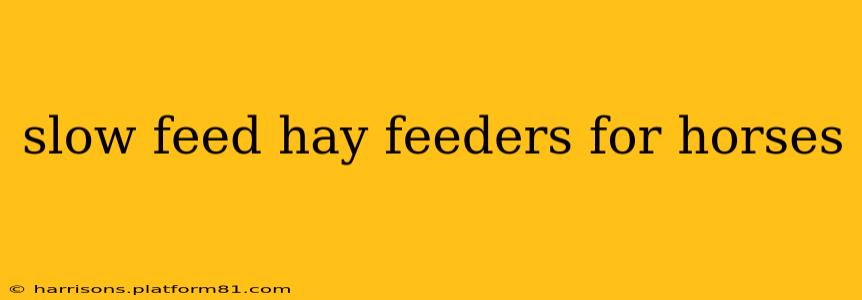Keeping your horse healthy and happy involves more than just providing adequate nutrition; it's about managing how they consume their food. For many horses, particularly those prone to obesity, colic, or digestive upset, a slow feeder can make a significant difference. These ingenious devices encourage natural grazing behavior, promoting better digestion and overall well-being. This guide delves into the world of slow feed hay feeders for horses, exploring their benefits, types, and considerations for choosing the right one for your equine companion.
What are the Benefits of Using a Slow Feed Hay Feeder for Horses?
Slow feed hay feeders are designed to make horses eat their hay more slowly, mimicking the natural grazing process. This has numerous advantages:
- Reduced Risk of Colic: By slowing down consumption, the risk of colic, a painful and potentially life-threatening condition, is significantly reduced. Rapid consumption can lead to gas buildup and digestive upset.
- Weight Management: Slow feeders help horses maintain a healthy weight by controlling their intake. This is particularly beneficial for overweight or obese horses.
- Improved Digestion: Slower eating promotes better digestion and nutrient absorption.
- Reduced Boredom and Stress: The act of foraging provides mental stimulation, reducing boredom and stress, which can lead to stereotypical behaviors like cribbing or weaving.
- Dental Health: The act of pulling hay from a slow feeder can help keep teeth worn down naturally, promoting good dental health.
What Types of Slow Feed Hay Feeders are Available for Horses?
The market offers a wide variety of slow feed hay feeders, each with its own design and features:
- Net Feeders: These are often inexpensive and readily available, resembling large nets filled with hay. They are a popular entry-level option. However, they don’t always provide as much of a challenge as other types of feeders.
- Hay Bags: Similar to net feeders but typically made of heavier-duty material, often with smaller holes to further slow down eating.
- Plastic/Metal Feeders: These come in various shapes and designs, often with intricate maze-like patterns to make accessing the hay more challenging. They're generally more durable than nets or bags.
- Slow Feed Balls: These spherical feeders hold hay inside, forcing the horse to work to get the hay out. They’re especially suitable for smaller spaces and individual feeding.
- Hay Dispensers: These are generally designed to attach to a wall or fence post.
How Do I Choose the Right Slow Feed Hay Feeder for My Horse?
Selecting the perfect slow feeder depends on several factors:
- Horse's Size and Eating Habits: A large horse will need a larger feeder than a smaller one. Consider your horse's eating speed and any existing digestive issues.
- Type of Hay: The type of hay you feed will influence the feeder's design. Some feeders might be better suited for long-stem hay, while others can handle shorter pieces.
- Budget: Slow feeders range in price from inexpensive nets to more robust, expensive models.
- Space: Consider the available space in your stable or pasture when selecting a feeder.
What if My Horse is a Very Fast Eater or Doesn't Seem to Get the Hang of the Slow Feeder?
Some horses are naturally fast eaters and may require additional strategies, even with a slow feeder. Here are some tips:
- Start Slowly: Introduce the slow feeder gradually to allow your horse to adjust. Start with smaller amounts of hay and gradually increase the quantity.
- Combine Feeding Methods: You could use a combination of a slow feeder and a traditional hay net for a gradual transition.
- Multiple Small Feedings: Consider feeding several smaller meals throughout the day rather than one large one.
- Consult with a Veterinarian or Equine Nutritionist: If your horse continues to have issues with eating, consult with a veterinarian or equine nutritionist to rule out any underlying medical conditions.
Are there any disadvantages to using a slow feed hay feeder?
While slow feed hay feeders provide many advantages, there are a few potential downsides:
- Cleaning: Some feeders can be more challenging to clean than traditional hay nets.
- Cost: More robust feeders are typically more expensive.
- Potential for Injury: If not properly secured, some feeders could present a risk of injury to the horse.
How often should I clean my slow feed hay feeder?
Regular cleaning is crucial to prevent the buildup of mold and bacteria which can pose health risks. You should thoroughly clean and rinse your slow feeder at least once a week.
What kind of hay is best for slow feed hay feeders?
Most types of hay are compatible with slow feed hay feeders. However, long-stem hay is often preferred as it encourages natural grazing.
By carefully considering these factors and choosing the appropriate slow feed hay feeder, you can significantly improve your horse's health, happiness, and well-being. Remember that consistency and proper management are key to maximizing the benefits of this valuable tool.
